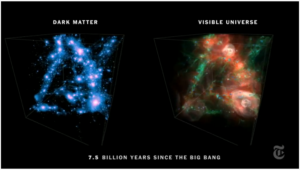Dark Matter: Mapping the Unseen Universe
 Just as 17th century microbiology pioneer Antonie van Leeuwenhoek used his homemade microscope to view the previously unseen world of microbes, scientists today are creating a map of the dark matter in the universe; applying computer models to the gravitational forces impacting the stuff that we can observe directly to theorize about the nature of what we cannot.
Just as 17th century microbiology pioneer Antonie van Leeuwenhoek used his homemade microscope to view the previously unseen world of microbes, scientists today are creating a map of the dark matter in the universe; applying computer models to the gravitational forces impacting the stuff that we can observe directly to theorize about the nature of what we cannot.
The brute mathematical truth is that atoms, the stuff of stars, you and me, make up only 5 percent of the universe by weight. A quarter of it is made of mysterious particles known as dark matter, and the remaining 70 percent a mysterious form of energy called dark energy. Physicists theorize that dark matter could be exotic particles left over from the Big Bang. They don’t know what it is, but they can deduce that dark matter is there by its gravitational effect on the things they can see.
To strip the greasepaint from cosmic history, astronomers have performed computer simulations of how dark matter would evolve from a nearly uniform cloud into the filaments and clumps characteristic of the arrangement of galaxies today in the luminous universe. A multinational group led by Mark Vogelsberger of the Massachusetts Institute of Technology has recently performed one of the most detailed of these studies yet, a calculation called Illustris.
I am struck by the amazing parallel between the shadow universe of dark matter and the discoveries van Leeuwenhoek made about the world of microbes. In both cases, the vast majority of the action was happening out of sight; humanity had to doggedly push the boundaries of the visible world just to see it.
Dent the Future is a conference series that tackles the art and discipline of visionary leadership. The next Dent The Future conference is coming up March 22-25, 2015. Register here.
